BBC's Blog, page 16
June 21, 2013
Links: BBC Weather app and Barb reporting
Hi time for another round up of news stories about BBC Online from the last two weeks.
The release of the BBC Weather app on Android and iOS gained a lot of attention. Senior product manager James Metcalfe blogged:
The iOS app has been created to ensure the best standards and guidelines have been followed so all interactions menus and settings should be very familiar to iOS users, such as a left navigation menu with search and edit functionality. The major difference for Android is the use of the action bar for search and the ability to offer an interactive home screen widget, which we are pleased to include in this first version. We added some fun stuff too like bumping two phones together to share your favorite locations over Near Field Communication (NFC).
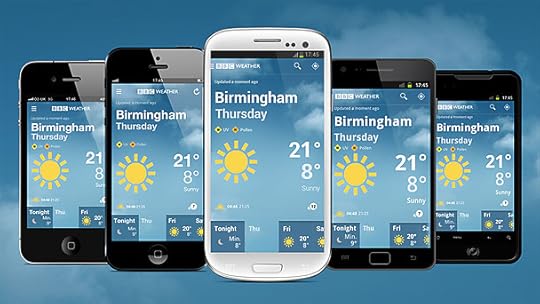
The BBC Weather app on different screens
Phones Review praised the new app:
It has a good clear design and features such as location search where you can store your favourites, or alternatively it can use your current location.
While Digital Trends commented:
With so many weather apps already available to smartphone users, the BBC will be hoping its high profile will help ensure its offering is a success. It certainly has some pretty stiff competition, with well-regarded alternatives like this one and this one already proving popular with users.
An article in the Sunday Express on the child protection safeguards in place for BBC iPlayer caused controversy this week :
Technology has made a nonsense of the 9pm watershed with evidence growing that youngsters are using the BBC’s internet iPlayer service to watch scenes of appalling violence against women in popular dramas such as The Fall and Ripper Street.
The story was picked up by the Daily Mail, which reported:
At the moment people calling up programmes on the service only need to tick a box confirming they are over 16 to watch adult material. The BBC does offer a parental lock but many households do not use this. Even young users of the service admit the ‘tick box’ method is fundamentally flawed in stopping youngsters watching adult material.
The Mail quoted a BBC spokesperson: “BBC iPlayer has controls in place to safeguard children from viewing and listening to guidance-labelled programming.”
You can read more about the BBC iPlayer Parental Guidance Lock on the iPlayer help pages.
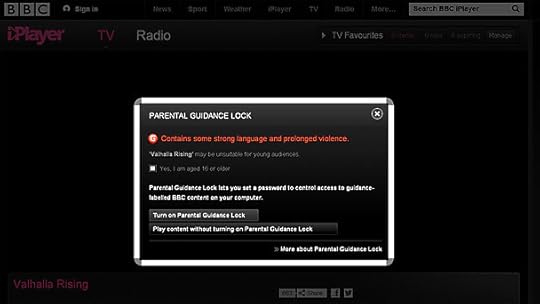
BBC iPlayer Parental Guidance lock
Barb, who report on the TV audience numbers for broadcasters such as the BBC has announced that they will also start reporting on Online viewing figures by the end of 2013. As reported by The Guardian:
Justin Sampson, chief executive of Barb, described the move as "pivotal". "Our initial focus is on reporting the extent to which IP [internet protocol] content is being downloaded or streamed. This is a significant step forward in our ambition to deliver cross-platform measurement of content.
"For the first time we will have a gold standard report into viewing to TV player services such as 4oD, BBC iPlayer, Demand 5, ITV Player and Sky Go," Barb said.
TechCrunch reported on a partnership between BBC and Storify, a service that allows users to create timelines using social media interactions. They have created a VIP service designed for “media organizations, publishers or anyone wanting to deeply integrate social curation and storytelling into their site.”:
One of the first companies to use the VIP service is the BBC, in what Storify describes as “one of our first formal partnerships with a media organization.” BBC developers have built a custom Storify integration for the BBC site
You can read more about how the BBC uses Storify for Live blogging on Jessica's post or check out our own Live Blogs.
The BBC has released its iPlayer performance pack for May. Digital Spy reported a record month for iPlayer Radio with 76 million programme requests.
The BBC announced its coverage of Wimbledon for this year will be “the most comprehensive digital coverage of Wimbledon ever this year, building on the success of the London 2012 Olympics. Audiences can follow an unprecedented amount of action, wherever and whenever they want to, with up to 10 live streams and on-demand content available across four screens - PCs, tablets, mobiles and connected TVs. “
And finally, the closure of the binder feature on BBC Food caused complaints. Andrew Pipes blog post has 152 comments to date.
What a retrograde step! The binder worked perfectly; why change it? The new favourites don't even work properly; why not complete the development before launching it? Don't change things if you are not making them better.
Andrew responded to audience comments:
We are releasing a bug fix this week that may be causing this issue for some. Basically, when some users try to sign in to their BBC ID, 'ssl' is prepended to the BBC Food website URLs. Try replacing 'ssl' with 'www' manually, and re-adding the recipe to your Favourites. If that works, then the fix that we will be releasing this week should solve your problems. If it still persists, then more details on the operating systems and browsers will help us narrow down the causes.
Thanks!
Eliza Kessler is the content producer on the Internet blog.
June 20, 2013
Vote 2013: the first step towards connected politics
Hi I’m Jonathan Austin, product manager for BBC’s elections coverage on bbc.co.uk/news.
The BBC is investing in its online political coverage to meet the challenges of the next four years. We took the first step on this journey in May, with this year’s local elections service called Vote 2013.
We overhauled our technology, introduced responsive design and, for the first time, published linked data concepts in News stories. Together this provides the core set of new features that will change how BBC News covers politics online.

Results on Vote 2013
The BBC’s charter agreement specifically mandates us to promote understanding of the UK political system and the next four years will bring unprecedented political activity.
There will be elections in Europe, the UK, Northern Ireland, Scotland and Wales. Scotland will decide on independence and the UK could also vote on EU membership.
In a period of potentially massive change the BBC’s role is more important than ever, which is why we are laying the foundations now, starting with our coverage of the local elections.
At first glance the results service looks similar to previous elections. But under the bonnet, everything was different.
Our results data system was completely overhauled. Hosted on the cloud it was quicker, more reliable, able to handle more data and could publish to multiple platforms.Vote 2013 was the BBC’s first responsive UK election result service. Just one election map and result table served all mobile, tablet and desktop users. Tom Maslen (technical lead, visual journalism) discusses the details in his Responsive News blog. For the first time we embedded semantic linked data on BBC News. Each result page contains RDF metadata pinpointing the location of the result. Jeremy Tarling (data architect) discusses this in his blog post.

News coverage of the elections on Vote 2013
Looking to the future, our new results system will allow us to publish yet more data, exposing the behind the scenes buzz of the BBC election war room that you see on TV. We will also push responsive design further to develop visualisations even better suited to mobile viewing.
The application of Linked data in News is perhaps the most important innovation.
Politics today is complicated. The challenge is to create an online service that unpicks this complexity and elegantly displays the facts to voters wherever they may be.
Linked data will help us do that by enabling us to bring content together into what we are calling connected stories.
It builds directly on the work the BBC did during the Olympics. You’ll hear much more about that from our team in the months to come. Vote 2013 was the first step on this journey.
Jonathan Austin is product manager for Vote 2013.
June 19, 2013
Live Blogging: In Depth
Hi, I am the product manager for blogs, comments, Tweet modules, moderation and message boards at the BBC.
We’ve recently launched a new feature which internally we’re calling ‘live blogging’ and I wanted to tell you a bit about this.
The primary purpose of live blogging is to allow BBC editorial teams to tell the evolving story of a live event or programme in real-time, using a blend of text, images, video and audio to give extra context for audiences.
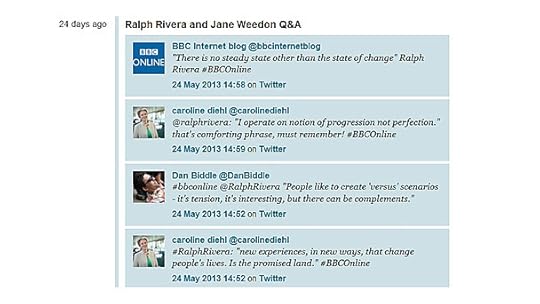
Screen shot of live blogging page as used for the recent BBC Online Briefing
This includes content from the BBC either hosted internally, such as clips and images, or uploaded via other sites such as Instagram and YouTube; as well as user generated content (UGC) submitted via comments, Twitter or Facebook.
As a concept this builds on the great experience we've generated across the BBC. Live text services have been successfully used by News and Sport for a few years now, running the Sportsday Live page for example and similar ideas were adapted for specific programmes and music events such as Glastonbury 2011.
However, it was clear that there was a distinct need for BBC editorial staff (initially those working in television and radio) to have a simple way to bring together internal, external and UGC content in an intuitive way.
Numerous tools have been used by the various teams in the past but each has had long-term costs and none have fully supported the changing needs of the BBC, so we started looking for a way to meet the requirements.
The approach
When we first came up with the live blogging concept we developed and user tested a prototype which showed that there was a keen appetite for this type of content and gave us some useful insights into how it should look and behave.
The next step was to look at what already exists and how we could adapt this to deliver the required functionality most efficiently. The front end of live blogging is an extension of our existing tweet module (an example of which you can see on the right of this blog post), but displays content from multiple sources.
The live blog itself is made up of a number of posts and each of these is denoted by a title which displays alongside an associated time stamp (showing how long ago this content was added relative to now). The post can be made up of a single content element (such as an image) or several different elements as the editor finds appropriate.
Following extensive discussions with staff about their requirements and an investigation into the existing tools used by the BBC we concluded that we didn’t need to build the editorial tool itself, at least for now, and we selected the Storify platform as the most suitable for our current needs.
Storify is a Social network service which allows users to curate content from a variety of Social media sources including Twitter, YouTube and Instagram.
A key attraction of this tool was how intuitive the user interface is for our editorial team, who want to focus on the content, without being hampered by a complex tool. Once the user has identified desirable content (such as a Tweet or article) they simply drag and drop it into the story; this can be supplemented with editorial commentary which they create themselves.
We are pleased with the feedback from the editorial teams about their experiences with this and how they are now using it more and more.
Where this is used
Some examples of live blogging include 6 Music’s 100 Greatest Hits in February which counted down the top 100 hits compiled by the team and asked the audience to vote for the greatest song released in 6Music’s lifetime.
127,000 unique browsers visited this page which was around half the number found to be listening live via the radio console (although these may or may not be the same people doing both!).
Additionally, Live blogging was used several times for Comic Relief, including for ‘Mark Watson’s Comedy Marathon’, ‘Miranda’s Mad March’ and the ‘Appeal Night Live blog’.
All in all, across Comic Relief there were 120,000 Unique Browsers visiting at least one of these live blogs between 12th and 18th of March. To put these figures in perspective this is around a third of those who visited the Comic Relief homepage in the same timeframe.
You can also see an example of an Eastenders live blog for a Question and Answer session with Jake Wood (who plays Max Branning in the programme); this shows one of the features we’ve introduced which utilises comments functionality and allows signed-in users to submit their thoughts and contributions without leaving the page. These are then seen by the editor who can choose to include them in the live blog.
What next?
We’ve also completed a feature which will be used to promote a live blog on other BBC Online pages with several customisation options.
The idea is to ensure that there’s a sense of liveness when a live blog is being updated so it shows the four latest headlines from that live blog which rotate every few seconds.
Additionally, there is an option to include an image, and the title and description are fully customisable.
Currently we’re doing some work to offer a version of the module which is more flexible. The main live blogging module stretches the full length of a page where this new version would adapt to the height of a defined container so it could easily fit alongside other media. This is an example of what the module could look like:

How a live blogging module might look
Above is an example showing how the flexible module might look if it were used by the Africa series for a Question and Answer session.
In this format the module is much narrower than the standard version and therefore requires slight differences in presentation (timestamps sit above the post titles rather than next to these for example).
Following this we’ll start looking at what the live blog should look like when it’s no longer being updated. Currently content displays in order of most recent first and the relative timestamps continue to update indefinitely; this can start to be confusing from the next day when each timestamp reads ‘1 day ago’.
We’re also looking at where other parts of the BBC are delivering a similar experience to live blogging in slightly different ways; we’re currently working together to ensure consistency and avoid duplication.
In mid-late 2013 we’ll also be integrating an Api which will enable us to bring this experience to other devices such as television and mobile applications, so extending the red button and companion scenarios.
Live blogging is still evolving and as such I’d love to hear your feedback and any ideas you might have for improvements; please leave your comments below.
Jessica Shiel is product manager, Social Publishing Services
Graduate Trainee Scheme in BBC Future Media: Working on iBroadcast
Hi! I’m Phil and I am on the BBC’s Digital Media Graduate Scheme. I should probably begin by explaining what this is all about.
On this scheme I rotate around BBC Future Media every six months for two years. This provides me with the opportunity to understand the overall picture of how the BBC’s interactive media is created including Smartphone apps, Red Button and BBC iPlayer.
The scheme, which has been running since 2011, is available to recent graduates and is run by the BBC Future Media division with a new intake every year. You can find out more about the scheme on the BBC Careers website.
I have just finished my first rotation with the team developing iBroadcast. My colleague Matt Browning has blogged in detail about iBroadcast.
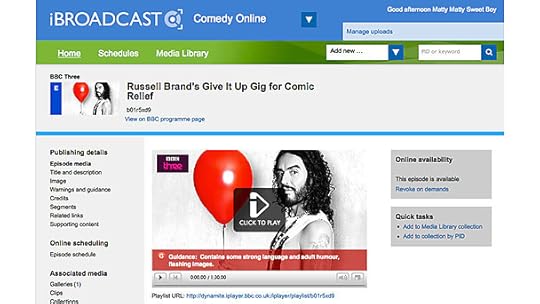
A view of an asset page in iBroadcast
iBroadcast is the web solution used across the BBC to manage programme meta-data such as video clips, images and rights and scheduling information across BBC online.
This includes content which sits on bbc.co.uk/programmes, bbc.co.uk/tv, bbc.co.uk/radio and iPlayer.
I am one of the people ensuring that the product is shiny for the BBC production teams using it and that it talks to the right data streams when changes are made.
Besides the product owner and project manager, our team consisted of 10 members and is set to expand. These are split between front and back-end developers, testers and UX designers.
While in this team I have been working on three main areas: credits and contributors, versions and scheduling and the migration of audio and video encoders from the old system to the new.
I use HTML, CSS, JavaScript and PHP in my day-to-day development process.
The work I have done on credits and contributors involved translating the product owner’s and UX designer’s requirements, such as the search functionality, placement of the thumbnail image and saving mechanism, into a functional part of iBroadcast.
This involved a team planning session, clarifying the user needs and splitting the requirements down into individual developer tasks.
For credits and contributors I have implemented a pop-up ‘lightbox’ so that the user stays on the same page in iBroadcast rather than being sent to different parts of the site. I used AJAX (Asynchronous JavaScript and XML) to handle the data between the user’s input and the BBC’s databases as they are interacting live with the page.
This particular feature was developed in two weeks in order to add new contributor information.
Following the completion of this we had an additional four weeks to give users the ability to directly import contributor information from existing programmes. This was a little more complicated than adding new data as we had to implement a search function and ensure that the information being copied is accurate.
As for the versions and scheduling system, this was put together over the Christmas period and is where I took significant responsibility over the implementation around the visual and functional side.
The goal was to enhance an existing feature in order to give the user more control over regional variants and timing of any scheduled programme in the system.
During the development of this section, my focus was programming in JavaScript, and I had to ensure that my code conformed with the standards of others who have worked on iBroadcast much longer than I have. It was honestly an exciting experience!
The User Experience & Design team crafted the layout to ensure that end users can get the most out of the information presented to them, and to keep this new feature in line with the iBroadcast styleguide.
The iBroadcast team follows the agile software development methodology and thoroughly uses scrum as a way to iterate through the development lifecycle.
Overall, I feel that I have gained a wealth of experience in my first placement by understanding the foundations of the meta-data found across the BBC’s online presence. I also cannot thank the team enough in providing me a warm welcome to the organization and assisting me in understanding the structure of BBC Future Media. I would have become lost without them!
I will continue to write about my experiences during my time at the BBC. If you have any feedback of what you would like me to discuss in my next post, please leave a comment and I’ll take it into consideration!
Philip Whitehall is a BBC graduate trainee.
June 18, 2013
Inside No. 9: Connected Studio for Comedy with the creators of Psychoville
Hi I’m Jon Aird, a producer with BBC Comedy and I wanted to tell you about an exciting experiment we’re trying out: Connected Studio is going to take the new series from Psychoville creators Steve Pemberton and Reece Shearmith called Inside No. 9 as the starting point for digital innovation.
While this particular Connected Studio will work slightly differently than in the past, we’re still on the lookout for digital agencies, designers and developers who can help us.

Steve Pemberton as Migg, Reece Shearsmith as Tom and Gemma Arterton as Gerri
At BBC in-house Comedy we're excited about working across all platforms. We have stand out shows on TV such as Twenty Twelve, on radio with The News Quiz and online there's the BAFTA award-winning Psychoville Experience. So it's a fantastic opportunity to join up with Connected Studio on this new project.
Each episode of Inside No. 9 is a darkly funny story with an unexpected twist.
Peeking behind closed doors you are invited into six very different No. 9s, from a grand old country house where a game of sardines leads to some chilling revelations in a wardrobe, to the flat of an apparently happy primary school teacher who becomes the victim of a good deed. The shows are funny, thrilling, thought provoking and immensely entertaining.
Steve and Reece are also keen to explore how the series can make the most of digital media so we’re going to invite the audience into an extra No. 9 by creating a special digital storytelling experience.
Because it’s destined for online audiences rather than TV we’re going to tell it in a different way and that’s where Connected Studio comes in.
We have a few ideas of what we’re after. As well as watching and listening to find out what happens next the audience might have to interact, for example by becoming a character in the story or taking control of the action in some way.
It could even remain a passive experience but call on the strengths of the latest technology to alter the way the audience experience it. The story might change depending on what we know about who’s watching or listening.
We’ve experimented with digital storytelling in the past, like this teaser for an interactive ghost story I produced called The Burning Room. Our aim for Inside No. 9 is to use digital technology to make a memorable experience that’s inherently different to anything audiences have seen before, as well as delivering another tale worthy of inclusion in the series.
So if you’re interested in new ways of telling stories and creating comedy using digital technology then head to the Connected Studio website for all you need to know about how to get involved.
Jon Aird is a producer in BBC Comedy.
June 17, 2013
Draft BBC Mobile Accessibility Standards and Guidelines
Hi I’m Henny Swan and I work in the Accessibility team which is part of BBC Future Media. We support teams within the BBC to ensure they deliver web content and applications that are accessible to disabled audiences.
For the past eighteen months my team have been working hard to improve the accessibility of web content for mobile sites and native apps.
It’s been an interesting journey as there are no internationally accepted guidelines for mobile accessibility so as a result we thought we’d write our own: the Draft Mobile Accessibility Standards and Guidelines which you can find on the Standards and Guidelines section of the BBC website.
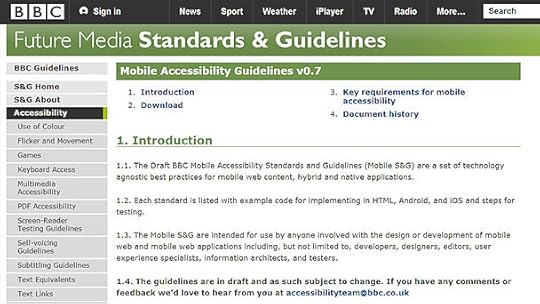
Draft Mobile Accessibility Standards and Guidelines
For years BBC teams have used the BBC Accessibility Guidelines to help them build accessible websites. This has proved a useful foundation for mobile accessibility however, we felt we needed something more targeted for device delivery and native applications.
There are differences between desktop only versus mobile web and application accessibility. Take for example colour contrast.
On the desktop web it is widely accepted that a contrast level of 4.5:1 is acceptable. On the mobile web, where users are on the move in changing light conditions dealing with variable levels of glare, it's questionable whether 4.5:1 is enough, so perhaps we should be aiming for something closer to 7:1.
Initially we developed a set of standards and guidelines for HTML, then iOS and Android as these are the platforms we identified most users were accessing content through and also have the most mature accessibility support.
The plan moving forward is to write techniques for additional platforms as and when the need arises, but this doesn’t stop our teams applying these standards and guidelines for Windows Phone, Blackberry and other platforms in the meantime.
By writing three sets of guidelines we laid the groundwork for us to understand where the overlaps between web and native app accessibility are. We then merged the three sets of guidelines into a single set of agnostic standards and guidelines with technology specific techniques.
Maintaining three separate platform specific standards and guidelines would have been a huge overhead and, more importantly, wouldn't have reflected how teams work within BBC where knowledge roles and skills transfer across different teams.
We referenced the Web Content Accessibility Guidelines, platform specific guidelines and other resources that had a good cross over with the mobile web.
We worked with SSB Bart Group, an accessibility software, training and consultancy firm in the States, to develop technology specific techniques to accompany the standards and guidelines. This also includes code samples in HTML, iOS and Android.
Evaluation criteria are also provided for each standard and guideline. We felt it was important for our teams to not just know what to do but also how to do it and how to verify they have implemented guidance correctly.
Each checkpoint is listed as either a ‘standard’ or a ‘guideline’ – the same model that our existing BBC Accessibility Standards and Guidelines use. A ‘standard’ is a checkpoint that must be supported and is testable. A ‘guideline’ is a checkpoint that should be supported, may be subjective and therefore might be less easy to test. This helps our Test team builds in concrete test criteria during Quality Assurance.
While the standards and guidelines have been developed we have been simultaneously building, testing and learning various techniques in making web applications accessible.
Our most notable releases to date include BBC iPlayer on iOS and Android, iPlayer Radio for iOS and Android, the Olympics and Sport iOS and Android apps, and the recent Weather apps.
We have also been integrating accessibility from the start for many responsive products including Barlesque (the header and footer of most BBC web pages and the framework providing core libraries, styles and modules), the TV Channel Home pages and more.
As with the standards and guidelines our apps and web content are a work in progress as we trial new techniques and keep up to date with the capabilities of the technologies and platforms to support accessibility. Our work here is far from done but hopefully we are well on our way.
Tell us what you think
This is a first step. We already have a list of updates that we are making to the standards and guidelines for the next release (which we hope will be soon).
What we’re really interested in however is your feedback so if you have any comments, suggestions, or additions for techniques or evaluation criteria we would love to hear from you either by emailing us or by leaving a comment below.
Henny Swan is senior web accessibility specialist in BBC Future Media.
June 14, 2013
What's on Red Button June 15-22
There's something for everyone this week, with a Holby City Red Button special, Horrible Histories karaoke, Bollywood music and Rick Stein recipes. Get ready for Wimbledon with tennis from Queen's Club and Eastbourne, and tune into Confederations Cup football in Brazil and MotoGP in Spain.

100 Years of Bollywood
Indian cinema's centenary celebrations continue on BBC Asian Network with a special Red Button programme that brings you highlights of 100 Greatest Bollywood Songs, BBC Three’s Bollywood spin on Bizet’s classic opera Bollywood Carmen and film icons who recently visited the UK including Jackie Shroff, Zeenat Aman and Ranbir Kapoor talking about their contribution to the biggest film industry in the world.
For more information and the full schedule, click here.
Available on Freesat/Sky/Virgin Media/Freeview
Mon 17 June, 7:30pm-9:55pm
Tue 18 June, 4:00am-6:00am, 6:00am-7:00am, 7:00pm-8:55pm
Wed 19 June, 4:00am-6:00am, 6:00am-7:00am, 7:00pm-6:00am
Thu 20 June, 6:00am-7:00am, 7:00pm-6:00am
Fri 21 June, 6:00am-7:00am, 7:00pm-6:00am
Holby: A Night Like This
Holby City fans, lean in, it's the Red Button special: Furious with Sacha over his treachery in harvesting Daniel’s bone marrow despite his hole in the heart condition, Chrissie storms out of the hospital and on a whim goes home with knight-in-shining-armour Michael. As Holby's hottest nurse and surgeon share tequila, confidences and life advice at Spence Towers, will their long-standing chemistry finally come to its long-awaited conclusion?
Available on Freesat/Sky/Virgin Media/Freeview
Tue 18 June, 8:55pm-4:00am

Rick Stein's India
Roughly 40 per cent of the population of India are vegetarian. With the amazing enthusiasm that everyone has for food, you quickly realise you could spend the rest of your life never eating meat and still be happy! The potential list of vegetable curries is endless and what’s more, they can be cooked in no time at all. Rick cooks dry fried okra with garlic, cumin and garam masala.
Available on Freesat/Sky/Virgin Media/Freeview
Mon 17 June, 9:55pm-4:00am
Tue 18 June, 4:25pm-5:10pm
Thu 20 June, 4:25pm-5:10pm
Horrible Histories Karaoke
Grab your hairbrush, take a trip back in time and sing along with the biggest names in history. From Vikings to Dickens, Joan of Arc to Rosa Parks, rock your socks off to the CBBC Horrible Histories Karaoke!
Available on Freesat/Sky/Virgin Media/Freeview
Sat 15 June, 6:00am-10:30am, 7:45pm-10:00pm
Sun 16 June, 7:45am-9:45am, 12:20pm-2:05pm
Mon 17 June, 7:00am-2:00pm, 6:00pm-7:30pm
Tue 18 June, 7:00am-1:45pm, 3:15pm-4:25pm
Wed 19 June, 7:00am-2:30pm, 3:30pm-5:10pm
Thu 20 June, 7:00am-4:25pm,
Fri 21 June, 7:00am-12:00pm, 1:00pm-5:10pm
Sport
For information on this week's schedule, see the BBC Sport website. Highlights include tennis from Queen's Club and Eastbourne, football from the Confederations Cup in Brazil and MotoGP action from Catalunya. Note times of live sport are subject to change.
Antiques Roadshow play along
Join in with Antiques Roadshow each week by guessing the valuations via the Red Button play along. You can now also play along on a mobile or tablet by downloading the play along app. Don't forget to tweet your scores to #antiquesroadshow.
Available on Sky/ Freeview
Jun 16th June, 7:55pm-9:00pm
Don't forget you can follow us on Twitter at @BBCRedButton.
College of Production Roundup: Writing for online and Pobol y Cwm
Hello I’m Paul Buller, editor of the BBC College of Production (CoP) website.
CoP is a free online resource for anyone working or wanting to work in TV, radio and online broadcast. The site is packed full of videos, podcasts and articles containing advice, tips and case studies from productions and people working right across the broadcast industry.
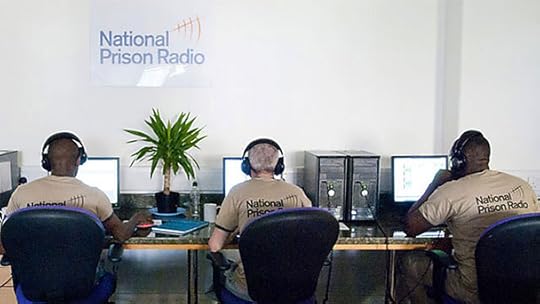
Making waves behind bars from the CoP website
This week the team from Wales’ most popular TV drama Pobol y Cwm talk about how they’ve used the online world to bring the soap to a whole new audience and with quite some success in the CoP Show podcast.
They talk about the challenges of taking a well-loved brand to a younger audience from getting the look and feel right to the differences between filming for the web compared to the linear television production of the main soap.
They discuss the partnership between S4C and BBC Wales and the logistics of working on bilingual website and film production in creating their spin off PYC.
How to do things well online is something more and more people in the broadcast industry are having to learn. So we got together three experts in their field to bring you some top advice on how to write for online.
Our panel outlined how writers have to be disciplined in order to shape their own content more effectively. It’s an interesting lesson in transferring writing skills to a new platform.
Finally, innovation abounds in this fascinating article on the prison radio service that has picked up no less than ten coveted Sony awards. It’s a unique project, and it’s brilliant.
Enjoy.
Paul Buller is editor of the BBC College of Production website.
New Media Literacy Strategy for the BBC
Hi I’m an editor for Media Literacy. The BBC has just published a new Media Literacy Strategy and I’m here to tell you about what media literacy is, why it’s important and how the BBC is helping people develop media literacy skills and confidence.
In recent years some of the big BBC media literacy projects like First Click focussed on getting people online for the first time. But developing a broader range of media literacy skills and increasing confidence are critical if we are to benefit fully from the wide range of content and services that are available now, whether that’s a new version of BBC iPlayer, YouView, Connected TV or Britain in a Day.
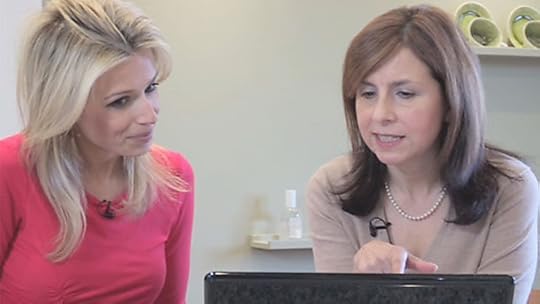
That’s why we developed the BBC Media Literacy Strategy which sets out our approach to promoting media literacy and provides a framework for commissioning and delivering projects which help people develop the skills to use, understand and create media.
Before I tell you more about this you might be wondering ‘What is media literacy?’ The answer isn’t easy and it’s changed over the years as media have evolved, but I think the best definition now is the one we use in the BBC: “The ability to access, understand and create different types of media”. So basically it’s about using the hardware, critically consuming and intelligently creating.
At an everyday level I think media literacy is about having the skills and confidence to continually benefit from the opportunities that new technology offers us. But that means having the skill and confidence to ask yourself and others certain questions like ‘How does this work?’, ‘Do I need to buy a new bit of equipment?’, ‘Is it safe?’, and ‘What does this mean and is this true?’.
The 2012 Understanding Digital Capability survey suggests that many of us find learning new online skills daunting, with one in three relying on others for help to learn new things. It’s not unusual for us to avoid trying new tasks unless we feel completely able to do so (I’m cringing as I remember how long it took me to back up my hard-drive for the first time…).
The questions we do ask are often influenced by factors like our age, our socio-economic background and our attitude to learning. Some people are great at jumping in and really exploring what they can do with the newest bit of kit or software.
But simply knowing how to use technology isn’t enough. It’s just as important to know when to hit the 'Pause' button in the brain and ask what might be the consequences of this new technology, good, bad or indifferent.
With technology constantly evolving and social norms shifting it means that the rules of digital engagement are not black and white. In fact sometimes it can be hard to tell the difference between risks and opportunities.
That’s why it’s so important for all of us to develop the skills and confidence to ask questions and get help to develop the skills we need to navigate our way through modern media. A good example of this is our award winning Share Take Care project.
This project saw BBC Learning, Radio 1 and CBBC come together to deliver coordinated online safety messages on Safer Internet Day about the risks around over-sharing information online. Aimed at children and young people, the results showed that this project helped the think about hitting that pause button and asking themselves the right questions at the right time.
Check out WebWise to see how the different channels used different styles to deliver similar messages.
With the BBC’s unique access to audiences we’re well placed to make people aware of the benefits of digital participation and the skills required. In fact, the duty to help people “build their confidence and skills, and encourage audiences to move from passive consumption to active participation and constructive engagement” is included as one of our Public Purposes in the 2006 BBC Charter and Agreement.
Central to the approach of the BBC Media Strategy are three long-term editorial themes and a comprehensive online content strategy to support them.
The Get Connected theme concentrates on helping people use emerging technology and get the most from the internet and we’ve created a suite of new online films for WebWise to help people develop a range of skills, from using a search engines effectively to downloading audio to understanding the basics of copyright.
The second work-stream, Get Smart, will focus on helping people develop the habits, behaviours and knowledge required for the best and safest online engagement and includes projects such as the Share Take Care campaign and initiatives such as News School Report and The Listening Project which help the audience develop a deeper understanding of how content is made, presented and accessed.
The third work-stream is Get Creative and focusses on helping people to develop creative and technical skills. Again, we are already active in this area with initiatives such as Free Speech.
Better media literacy skills can make a big difference to how you engage with the world around you. So go on, ask some questions.
Martina Chapman is an editor for Media Literacy.
June 13, 2013
Developing the camera for Horizon: The Secret Life of the Cat
My name is Alia Sheikh and I recently blogged about my role on BBC Research and Development (R&D) Production Labs, but I have also been working on the BBC Two programme Horizon: The Secret Life of the Cat.
In BBC R&D we're used to working on cutting edge technology for broadcast use so my colleague Tony Richardson and I were really excited when Horizon approached us to develop the cat-cams which were to be used to track the lives of several cat subjects.

Rosie the cat with her cat-cam
They needed cameras that would be light enough to be worn by cats day and night to give the audience a cat’s eye-view without constricting their movement.
Working with the Royal Vetinary College we decided that although the camera weight would ultimately depend on the size of the cat, we should aim for approximately 35g per camera.
We also needed the ability to record a Global Positioning System (GPS) log of the cat’s movements and also make sure we reserved the battery of the camera when the cat was inactive.
Since the safety of the cats was a priority the cameras needed to be on quick-release collars that would easily detach if caught in anything and we also needed some sort of homing beacon to let us find the cameras again if they did fall off.
Initially we considered using GoPro cameras but even the smallest and lightest version is 73g, over twice the target weight. Existing pet-cam products are available but typically produce a lower quality picture than we were aiming for. We also looked at the tiny cameras used in spy watches before dismissing them as too tricky to work with in the timeframe available, we wanted a camera we could easily modify for our own needs.
We therefore chose HD808 keyring cameras which are popular with model aircraft enthusiasts due to their small profile, extremely light weight and the ability to swap out the lenses.
We took a HD808 camera, stripped back the casing to remove some weight and moved the lens assembly from the side-edge of the camera to the front-centre and used 120 degree wide angle lenses, meaning we could get a stable picture on a cat.
We swapped the battery for one that would last longer and removed the infrared cut-off filter (IR filter) then encased the prototype in lightweight foam to create our first prototype.
We lent the camera to the show's producer who fitted it onto her cat and let it roam free.
The initial tests were successful and the camera hung at just the right height to capture the cat's whiskers as it moved about. We later learnt from Dr. Ellis of Lincoln University that the movement of cats whiskers tells us a lot about its mood and behaviour, so it was very useful to have them in shot.
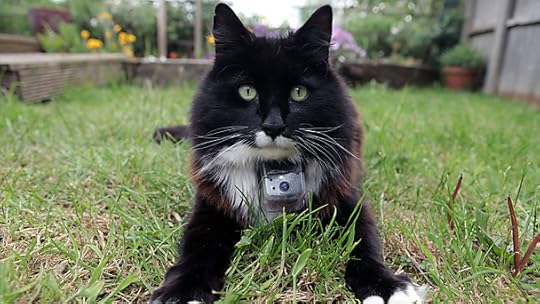
Kato with cat-cam
Although our prototype cat-cam was incredibly lightweight it was also quite bulky due to the liberal amount of duct-tape used in its construction. In some ways this was a good thing as the camera was cushioned against the cat’s neck and therefore gave nice stable pictures.
However, we were worried that a bulky camera would get snagged in something or affect behavior, so clearly the padding would have to go.
We also found that the camera battery was not lasting as long as we wanted and after some testing we realised that we could drop down from four light-emitting diode's (LEDs) to one without losing any quality in the image, but saving massively on battery life.
However, we still didn't have a camera that would record all night and the concern was that we would end up with hours of sleeping-cat footage and miss the real action.
The solution was to collaborate with design engineer John Lowe who was developing the GPS units to track the cats. This unit was wired into our cat-cam and meant we could see to turn on the camera and LEDs only when the cat was active. This saved on battery life allowing us to have footage throughout an eight to 10 hour period before recharging.
The GPS units needed to be mounted on the collar at the back of the cat's head in order to get a good signal and our cat-cam hanging under the cat's chin provided a good counterweight to keep it in position. We also added a small radio beacon to the camera so we could find them if they dropped off.
Each successive cat-cam prototype was smaller and lighter than its predecessor, progressing from foam-encased to moleskin-fabric-wrapped to finally small vacuum-formed boxes that sat discreetly under the cats chin.
The cameras were configured to the highest possible bit rate settings and a series of tests determined the best settings for daylight and night time filming to get the highest possible picture quality.
The cameras had to be taken in after each night time or daytime filming slot so that they could be recharged, so a certain amount of time was spent waiting for the cats to come home.
For daylight filming we needed to put back the IR filter which we had removed from the back of the lens. The filter acts to block out infrared light which can wash out an image taken in daylight. After a number of unsuccessful experiments making slip-on IR filters for the front of the lenses (all of which were lost by the cats) we decided that it was simplest just to swap over lenses.
Lenses with IR filters stuck to the back were used for daylight filming and lenses with the filters removed used at night. They were refocused with a pair of tweezers each time we swapped them and the camera was hooked up to a computer so we could flip between the day and night settings.
At the end of a day’s filming we’d decant the footage and John would copy the GPS data across. Using this data, researchers from the University of Lincoln were able to quickly determine the cat’s movement and behavior in different locations which was taken into account when John reprogrammed the collars for the next round of filming.
Looking back, having an easily accessible test-cat would have sped up the development a lot. We were delighted with the footage we got back from the cats, one thing I have learned from this project is that a cat actually makes a pretty decent camera operator.
Alia Sheikh is a technologist for BBC Research and Development.
Read more about the infographics used to illustrate The Secret Life of the Cat on editorial designer Helene Seare's blog and about the programme on the BBC TV blog.
Find out more about Research and Development projects on the R&D blog and website .
BBC's Blog
- BBC's profile
- 28 followers



